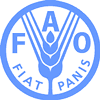 |
|||||||||
|
|||||||||||||||||||
|
|
New FAO Report Assesses Dairy Greenhouse Gas Emissions 2010-04-20 The dairy sector accounts for around four percent of all global anthropogenic greenhouse gas emissions (GHG) according to a new FAO report. This figure includes both emissions associated with the production, processing and transportation of milk products as well as emissions related to meat produced from animals originating from the dairy system.
Considering just global milk production, processing and transportation and excluding meat production, the sector contributes 2.7 percent of global anthropogenic GHG emissions. In 2007, the dairy sector emitted 1 969 million tonnes of carbon dioxide (CO2) equivalent, of which 1 328 million tonnes are attributed to milk, 151 million tonnes to meat from culled dairy animals, and 490 million tonnes from calves from the dairy sector that were raised for meat. The CO2 equivalent emission is a standard measurement for comparing emissions of different GHGs. The global average of GHG emissions per kilogram of milk and related milk products is estimated at 2.4 kg CO2 equivalent. Methane contributes most to the global warming impact of milk, accounting for about 52 percent of the GHG emissions in both developing and developed countries. Nitrous oxide emissions account for 27 percent of GHG emissions in developed countries and 38 percent in developing countries. Carbon dioxide accounts for a higher share of emissions in developed countries (21 percent) than in developing countries (10 percent). The FAO report, Greenhouse gas emissions from the dairy sector, covers all major milk production systems from nomadic herds to intensified dairy operations. It focuses on the entire dairy food chain, including the production and transport of inputs (fertilizer, pesticide and feed) used for dairy farming, on-farm emissions and emissions associated with milk processing and packaging as well as the transportation of milk products to retailers. The margin of error of the estimates is ±26 percent. "This report is fundamental to understand and identify opportunities for reducing the environmental impact of the dairy sector while providing safe and nutritious foodstuffs," said Samuel Jutzi, Director of FAO's Animal Production and Health Division. The assessment is part of an ongoing programme to analyse and recommend options for climate change mitigation. The next step is to use a similar approach to quantify GHG emissions associated with other major livestock species, including buffalo, poultry, small ruminants and pigs. The effectiveness, welfare and trade implications of policy options will then be carried out through economic modelling. A final report will be published in 2011. In its landmark 2006 report, Livestock's Long Shadow, the FAO found that 18 percent of all greenhouse emissions were caused by the livestock sector, using an aggregate life cycle approach. The final report on livestock GHG emissions will use the same approach but with updated data and providing a breakdown into different production systems, as well as indicating solutions for policy-makers, producers and processors.
|
||||||||||||||||||

|
|
||||||||||||||||||
| home | agri-services | pedigree
pen | news | dairy | beef | machinery property | organisations | site map |
|||||||||||||||||||

